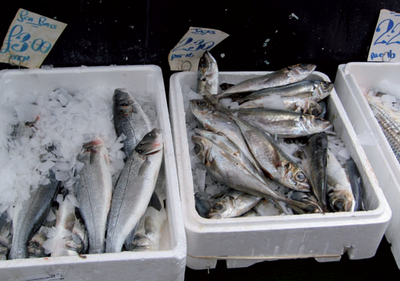Archive:Developing fishery statistics at Eurostat
- Published in Sigma - The Bulletin of European Statistics, 2010/01
Fish know no borders and the activities of one fishing fleet have a direct impact on fishing opportunities of other fleets, on the future of fish stocks and on the marine ecosystem. Therefore, the European Union (EU) has established a common fishery policy. Today too many vessels chase too few fish, which has resulted in the depletion of fish stocks, smaller catches and lower income for fishermen. To tackle this no-win situation the European Union has reformed its fishery policy and recommended cuts in fishing quotas and fleets. To support the revamp and the evaluation of old and new policies, data are essential.
Introduction
Eurostat’s fisheries statistics work programme is first and foremost designed to support the EU’s Directorate- General for Maritime Affairs and Fisheries to analyse different aspects of the EU’s common fisheries policy.
Eurostat’s fisheries collection, which is one of the largest and most comprehensive databases of fisheries statistics in the world, is also used to respond to requests from other EU institutions — primarily the European Parliament and the Council — as well as national authorities, international fisheries organisations and the public at large.
Comprehensive data with a long history
‘Eurostat fisheries and aquaculture statistics are collected in a well coordinated way, with a coherent and tight legal framework. Our data series also have a long history. The first fisheries yearbook was published already in 1975,’ said Gita Vergina, Head of Eurostat’s Agriculture and Fisheries Unit.
Eurostat’s data collection is divided into four groups: catches, landings, aquaculture and fl eet statistics. Annual catch statistics are collected by species and by area in the Atlantic Ocean, the Mediterranean and the Indian Ocean, which are the most important fishing areas for the EU-27.
Data on landings include the quantity and average price of the fish or fish products at their ports. These data are broken down by species and by flag of the fishing boat.
The aquaculture data include information on, the production and value of aquacultures, the input on hatcheries, nurseries and capture-based aquaculture — which is when you catch fish and ‘fatten’ them in captivity — as well as the structure of the sector.
Together with the Commission Maritime Affairs and Fisheries DG, Eurostat also keeps data on the number, size, tonnage, power and age of the EU fi shing vessels.
The bible of fishery statistics
Standard concepts, definitions, classifications and procedures for the collection of fishery statistics are developed in the Coordinating Working Party on Fishery Statistics. This international body, which is coordinated by the Food and Agriculture Organisation (FAO), has 15 international organisations including Eurostat, as members.
‘The coordinating working party for fish is a central reference point for international organisations working in the fisheries statistics world. As fish are international resources, statistical coordination between different parts of the world is unavoidable,’ said Franco Zampogna, Head of the Fishery Section at Eurostat.
‘Eurostat is a key contributor, especially for questions dealing with the North Atlantic, the Baltic and the Mediterranean Seas, which are among the most productive fishing areas in the world. Eurostat also plays a leading role when developing standards and definitions in the aquaculture area, among others, in giving a major input to the revision of the FAO’s handbook of fishery statistics, which could be considered as the bible of the fishery statistics,’ he continued.
New integrated approach
Initially the EU’s fisheries policy focused on the management of marine resources and the structure of the fishing industry. Today, socioeconomic aspects are integrated and the aim is to develop sustainable fisheries by analysing the economic performance of the EU fleet.

In 2007, the European Commission launched an integrated maritime policy, which addresses the development of EU sea-related activities. Previously the activities were dealt with sector by sector — transport and energy, tourism, environment, industry and shipyards, employment, regional aspects, etc. The new policy recognises that all matters relating to Europe’s oceans and seas are interlinked and that the waters surrounding the European continent are a vital natural resource and a main driver of Europe’s growth, jobs, competitiveness and prosperity.
Eurostat’s contribution to an integrated maritime policy focuses on providing statistical data related to each subdomain and data for long-term analysis,’ said Mr Zampogna.
‘Additionally, Eurostat plans to collect data on supply balance sheets for fishery products, employment statistics and to produce sustainable fisheries indicators,’ he continued.
Today one important sustainable fishery indicator produced in cooperation with the International Council for the Exploration of the Sea (ICES) is the percentage of catches taken from stocks outside safe biological limits. Other indicators related to the fishing fleet are being discussed with stakeholders.
Modernising the infrastructure
Eurostat’s fisheries team is also working hard to modernise the infrastructure of its database and to improve its data’s user friendliness.
‘The reform of the EU’s fisheries policy has led to new data needs as well as requests for quality improvements, in particular regarding the methodology. To become more efficient we aim to make better use of modern IT tools for data transmission and processing, as well as making more efficient use of resources,’ said Matthew Elliot, Statistical Officer in charge of data management and coordination for fishery statistics at Eurostat.
The European Union’s negotiations with Iceland on its future EU membership are another point on the agenda. When the Icelandic foreign minister, Ossur Skarphéðinsson, handed in the application in June 2009, he stated that fishery would be particularly important for Iceland in the accession negotiations that lie ahead.
‘However, we do not see any major issues for fisheries statistics. Standards are good and we have worked together for a long time in the framework of the European Economic Area,’ said Mr Zampogna.

